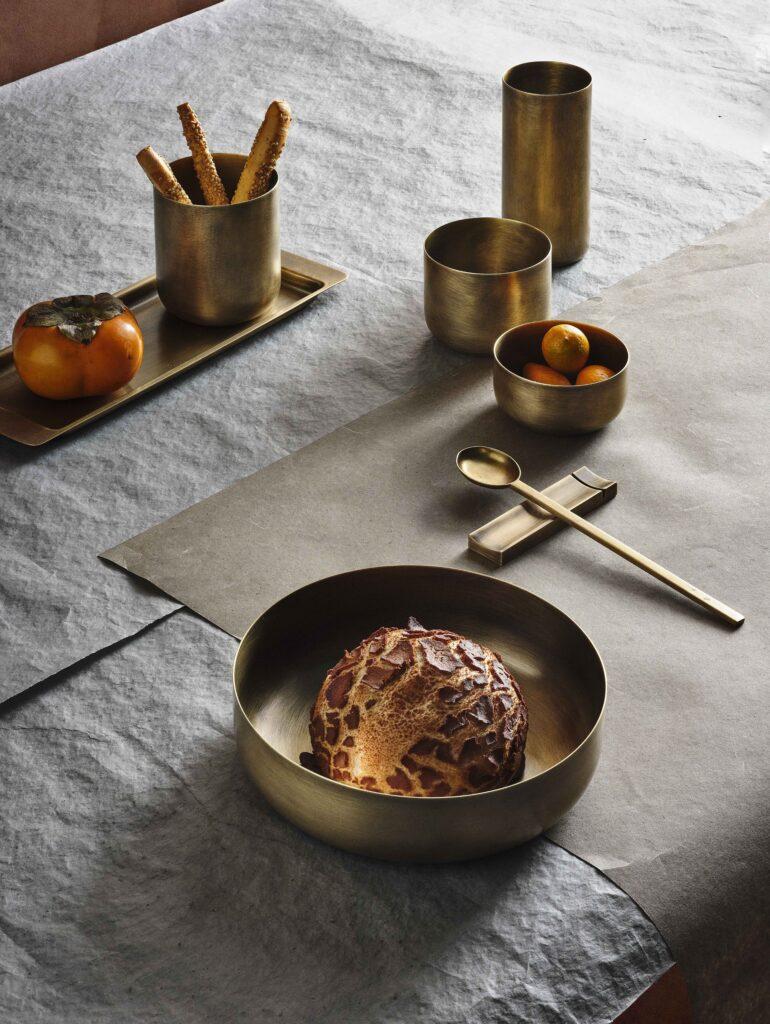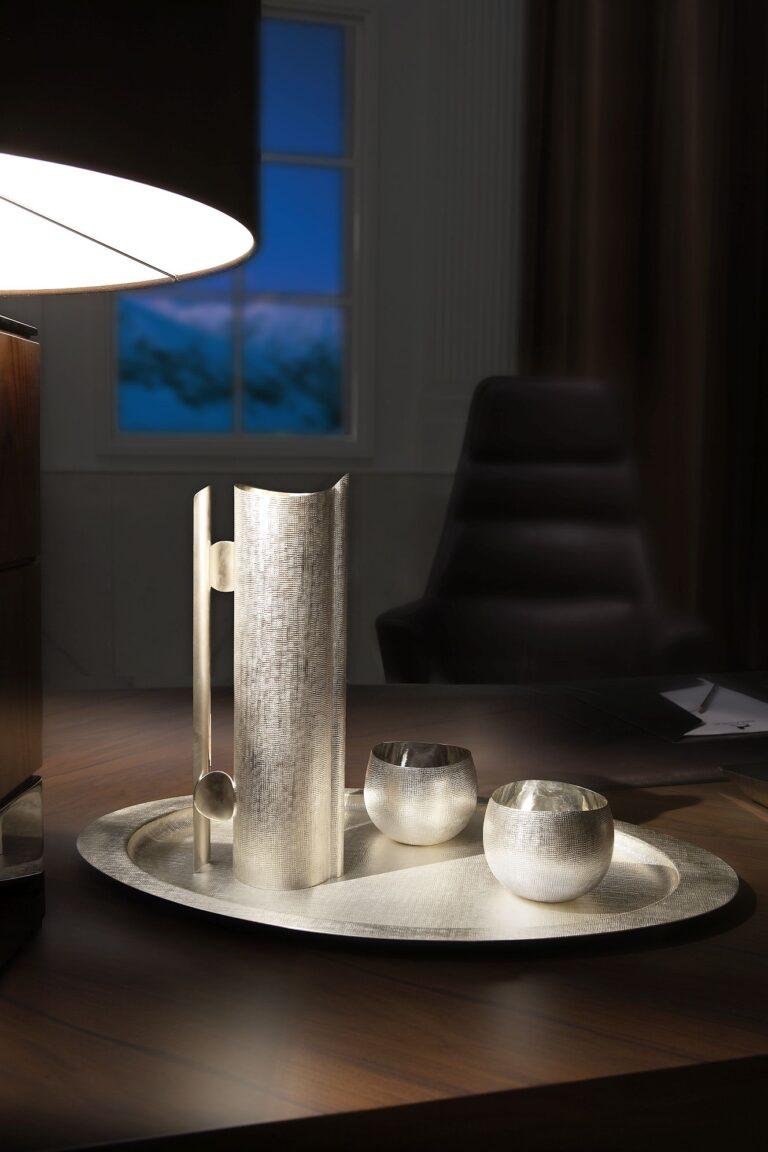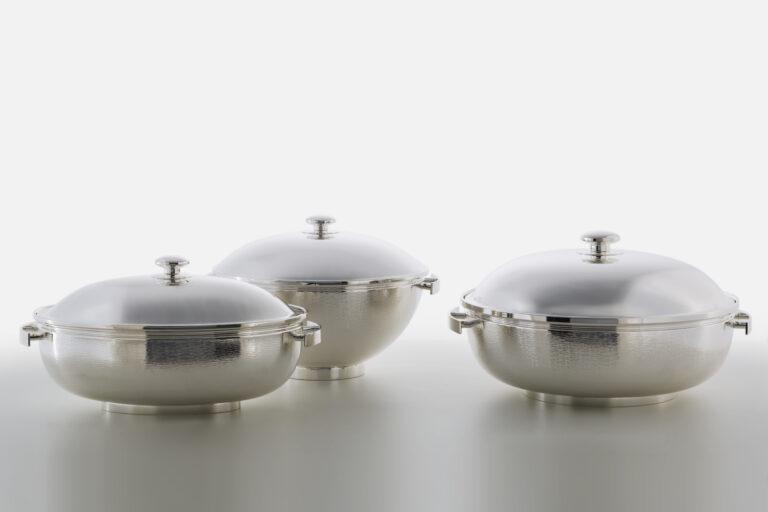Made using the key principles of Italian luxury craftsmanship: high- quality materials, age-old techniques, and respect for the environment, Zanetto is now in its 59th year of production and never been stronger.
The unique and precious home decor and tableware items are painstakingly crafted by hand, with the aim of preserving the history, savoir-faire and fascinating techniques of metal processing.
FOUR speaks to Enrico Zanetto about how he made his mark on the iconic brand, and continues to lead Zanetto’s creative legacy into the future.
Can you explain a bit about your background and how you got into design and artistic metalworking?
Since I was a boy, alongside the more rational part of my personality, to which I owe my studies in economics, I felt a particular artistic sensitivity alive and strong in me. A creative side which, from my younger age, found fertile ground and expression in my father’s applied arts studio. My father was a silversmith, so designing tableware and décor was the best way for me to explore my creativity.
Since 1983 I have been designing decorative pieces, declining noble metals following my artistic instinct. The 80s were fundamental years in which I developed my own style and received the first awards and recognitions. Since then I have nourished this passion by enriching it with very different contexts: I express myself not only through the creation of objects, but also through painting and sculpture.
What was the inspiration for creating Zanetto?
Zanetto was created by Bernardo, my father, in 1963, thanks to his very strong spirit of independence and freedom. Immediately he wanted to break away from the repetition of the models and canons of traditional silverware, challenging his abilities and affirming his personal style.
Search for new shapes, development of new techniques that enhance the artisans abilities and mastery in shaping metal, those are the pillars he founded Zanetto on and that I keep pursuing with determination.
How have the brand and the collections evolved since you joined the company in 1983?
When I joined in 1983, the company was looking for a new way, facing a world with new paradigms and new needs. My first intention was to give a more precise positioning to the brand, developing collections of tableware with which to obtain a market consolidation. The designs of those years are the result of the fusion, the interaction between my creative flair and that of my father. Objects came out of it in balance between simplicity and timeless beauty, with soft and full lines.
Hence my second goal: to give a unique identity to the brand. I therefore decided to highlight and enhance the greatest peculiarity among our technical skills: the hammering. Hammering is an art, it’s a rather complex technique part of the process of working metals. It could appear easy but, in order to master it, an artisan needs ten years of experience. It is very difficult to explain it in theory. The metal is hammered with different hammers and “irons” of a variety of shapes, depending on their use. Those characteristic weaves that are unique to the texture of our pieces are created through the use of this technique. Thus, was born the AFRICA collection, presented in 1997, a real revolution in the panorama of silverware at that time, and it soon become a great success.
What makes Zanetto’s designs different from other silverware in your opinion?
I think I know where the uniqueness of Zanetto’s design lies, it is through art and design that I express my soul, my search for the absolute. Each work intends to express a knowledge, an awareness, it is the attempt to transcend matter in the beauty of the spirit. Plus, our objects are still created by hand in our workshop in Italy. Zanetto artisans craft the metals as unique work-of-arts. Each object requires time and patience to be created, this gives a very special allure to our products and it really enhances my designs.
How would you describe Zanetto’s silverware to those who haven’t seen them?
There are numerous ideas and characteristics to refer to when describing Zanetto. I choose to talk about textures and surfaces, which are the true identity and uniqueness of Zanetto. I speak of hammering because it shows the manual skill of the workmanship and the uniqueness of each object.
The arcane textures possess a rhythm, confer absolute certainty to the form and dialogue with the user in a sort of ancestral alphabet, which speaks directly to the man of man. Once you see one of our designs you will be able to recognise our products all around the world cause our textures are very unique.
Do you have a signature style?
I am a free spirit, who expresses himself in a multiform, multidimensional way. I like to experiment, to evolve. But I think my style is recognisable. I try to create above fashion and time, keeping the design timeless.
How important is it for you to champion local artisans, craftsmen and components?
It’s essential. We are always looking for artisans and people who want to learn to work metals. Even if in the last decade it has been difficult to find young people interested in becoming artisans, I am sure that in a few years the world will be completely different from what it looks like today. Craftsmanship will become again essential in the journey of self-expression and self-realisation.
What have you been working on recently?
We are doing the re-edition of one of Zanetto’s classic collections. The collection will be launched in the first trimester of the new year so I can’t share a lot. I will just say that it will be a triumph of silver, with neat shapes and refined details. Soon on your tables!
Where do you get inspiration from?
I like to be inspired by anything. Nature is a great source of inspiration for me. But the main source is the world of the spirit, which is accessed every time the voice of the mind is turned off, every time the heart is allowed to be expressed. And every night when you enter the phantasmagoric dream world.
What’s next for Zanetto?
Interpreting the world that is to come, developing our business in the MENA region and continuing to pursue our mission of social responsibility.
These are the main aspects we will work on. Zanetto is a small luxury brand yet a big example of commitment to create beautiful works with significant intrinsic and aesthetic value. I will continue to work, striving for this alchemy to persist.
To explore Zanetto’s collection of beautiful homewares, go to www.zanetto.com/en/











